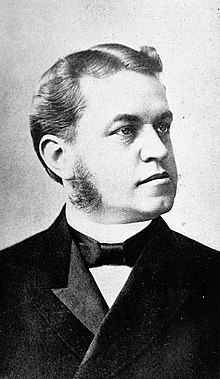John L. Bates
| John Lewis Bates | |
|---|---|
 |
|
| 41st Governor of Massachusetts | |
|
In office January 8, 1903 – January 5, 1905 |
|
| Lieutenant | Curtis Guild, Jr. |
| Preceded by | Winthrop M. Crane |
| Succeeded by | William Lewis Douglas |
| 38th Lieutenant Governor of Massachusetts | |
|
In office January 4, 1900 – January 8, 1903 |
|
| Governor | Winthrop M. Crane |
| Preceded by | Winthrop M. Crane |
| Succeeded by | Curtis Guild, Jr. |
| Member of the Massachusetts House of Representatives | |
|
In office 1894-1899 |
|
| Personal details | |
| Born |
September 18, 1859 Easton, Massachusetts |
| Died | June 8, 1946 (aged 86) Boston, Massachusetts |
| Political party | Republican |
| Spouse(s) | Clara Elizabeth Smith |
| Profession | Lawyer |
| Religion | Methodism |
John Lewis Bates (September 18, 1859 – June 8, 1946) was a lawyer and politician from Massachusetts. A Republican, he worked to promote East Boston, securing legislative approval of the first tunnel under Boston Harbor, joining the neighborhood to the rest of the city. From 1903 to 1905 he served as Governor of Massachusetts, notably upsetting the Republican establishment with his organizing tactics, and then alienating his own supporters with some of his executive actions and proposals. He later served as chair of the Massachusetts Constitutional Convention of 1917–1918.
John Bates was born in North Easton, Massachusetts to Rev. Lewis Benton Bates, an itinerant Methodist minister, and Louisa D. (Field) Bates. He attended public school in New Bedford, Chelsea, Taunton, and eventually the Boston Latin School. He then attended the Methodist-affiliated Boston University, earning an A.B. in 1882, and went on to graduate from Boston University School of Law in 1885. Over the next decade Bates practiced law in Boston, residing in its East Boston neighborhood. He married Clara Elizabeth Smith on July 12, 1887.
Bates, a Republican, first served on Boston's Common Council, and then won election to the Massachusetts House of Representatives in 1893. He served in that body from 1894 to 1899; from 1897 to 1899 he was Speaker of the House. During this period Bates built a ward-based political support system that was largely independent of the existing party infrastructure; his election to the speakership came without party support. Beginning in 1891, Bates began promoting improved transportation connections between East Boston and the rest of the city (from which it is separated by the inner Boston Harbor). Early proposals for a bridge went nowhere, and he instead began working on a tunnel proposal. This proposal met with opposition from Boston's leadership, which did not wanted to be saddled with its construction costs. Bates convinced Mayor Josiah Quincy to accept a toll of one cent per rider, securing agreement for its construction. Opened in 1904, while Bates was governor, it was the first of the harbor's tunnels, and now carries the MBTA Blue Line.
...
Wikipedia
